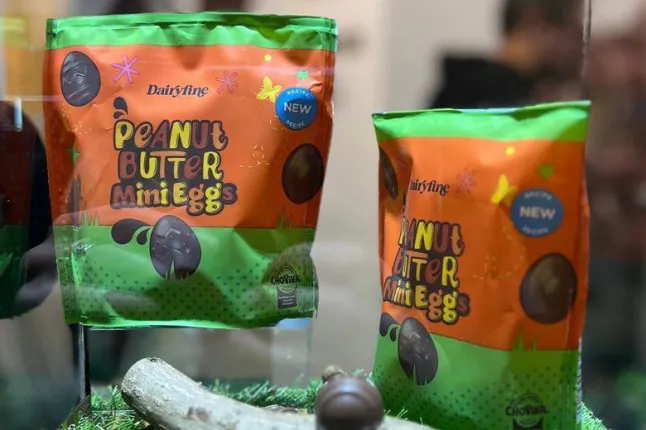Shortages and inflated prices in the cocoa industry have pushed startups to create chocolate alternatives that taste and feel like the original. Investors are taking a bite.

There is bad news for chocoholics — cacao bean supplies are running low.
While demand for chocolate continues to soar, the supply chain has been hit by climate change, deforestation, crop diseases, corruption within political structures and more. As a result, prices have quadrupled, soaring to a point where the chocolate industry has started to look for cost-effective and sustainable alternatives that can match the taste and texture of traditional chocolate.
“The market is seeing a kind of disruption around cocoa supply at the moment and is looking for some alternatives that can work along with cocoa,” says Giacomo Fanin, managing director at Grey Silo Ventures (GSV), the corporate VC arm of Italy-based Cereal Docks. “I don’t think cocoa is going to disappear, but the market needs other options right now.”
A number of startups have emerged recently to offer alternatives to cocoa and its byproducts. While the sector is still in its early stages, the emerging alternative chocolate startups are using easily available or under-utilised agricultural products as their base and focusing on sustainable production, taste and texture and price parity with cocoa in their final products.
There are also some startups like Celleste Bio and Kokomodo that have developed a method of growing cocoa beans in the lab. Celeste Bio’s process, for example, involves a one-time use of one or two beans from a single cacao pod and then growing them in a controlled laboratory environment. Mondelēz International is one of the startup’s backers. California Cultured, a US startup making cell-cultured cocoa products, announced a deal to supply Japanese confectionary company Meiji last year, and Finnish chocolate maker Fazer is also exploring cell-cultured cocoa.
Taste test
For an alternative food item to make sense, taste and texture are of paramount importance. This was a crucial test that alternative chocolate maker Planet A foods passed to win investment from Burda Principal Investments (BPI), says Luisa Düsberg, principal at the unit.
“Food has to be convincing in terms of taste and texture, right? We had that familiar feeling when we tested Planet A Foods’ products. We sampled cookies, chocolate bars that were made using the startup’s cocoa-free chocolate product, and it was highly convincing.
“Also, when we made the investment decision, we saw the product was already visible in the market and the broader consumer landscape was keen on buying it. So it wasn’t just us who were convinced – business customers, end consumers and retailers involved as well,” she says.
BPI, the investment arm of media company Hubert Burda, led the $30m series B investment for Planet A Foods in December 2024. The startup uses traditional fermentation and roasting methods to transform oats, sunflower seeds and shea butter into ChoViva, its cocoa-free chocolate product. ChoViva products are presently available in Aldi stores across the UK.

Taste played a role in Grey Silo’s $3.7m seed investment into Italian alt-chocolate startup Foreverland Foods in October 2024, says Fanin. “Their product’s taste is very similar to the taste of chocolate. It’s not going to replace premium chocolate, but it’s identical to the taste of the chocolate that is used in various confectionary items. I don’t see a difference there.”
Sustainability is the name of the game
Around 60% of the world’s cocoa harvest comes from the Ivory Coast and Ghana, an area that has been severely affected by climate change in recent years. Harsh weather has left cocoa farms particularly vulnerable, effectively ensuring lower output and unaffordably high global cocoa prices, as highlighted in a recent Bloomberg article.
“There are a lot of different issues with these two countries in the sub-Saharan region,” says Düsberg. “Cocoa production there has been hampered by ongoing droughts and flooding, as well as really old trees that have caused a reduction in harvest. The trees have also been hit by the swollen shoot virus that effectively means they need to be cut down in a large periphery. Then there’s the fact that cocoa production uses a lot of water. All of this isn’t the most sustainable.”
The sunflower seeds that ChoViva uses as its main base don’t suffer from these issues. “There’s a completely different starting point in terms of the needs of the product. The supply chains are much shorter since the seeds are sourced from Europe; there’s no deforestation involved. Also, unknown to a lot of people, there’s a lot of slavery involved with cocoa harvesting, which isn’t the case here,” says Düsberg.
Fanin has a similar view. Foreverland Foods alt-chocolate product Choruba is produced using carob, of which Italy is the second largest producer in the world. “There is no need to build a supply chain because the production is already there. Only carob seeds are used in the food ingredient sector – the rest of it is thrown away. Foreverlands mixes the waste product with grains, sugar and vegetable fats to make chocolate that requires 90% less water and emits 80% fewer greenhouse gases.”
The price is right
Another reason that makes the alt-chocolate options more viable is price parity. As cocoa prices have skyrocketed, the alternatives are looking increasingly competitive on price.
“Cocoa used to be priced at an average of $2,500/tonne for the last 50-odd years. It’s around the $9,000 mark now.’
Luisa Düsberg, Burda Principal Investments
“Cocoa used to be priced at an average of $2,500/tonne for the last 50-odd years. But the prices quadrupled in late 2023-early 2024. It’s around the $9,000 mark now. This cuts into margins for food producers, adds insecurity in the supply chain and causes huge price volatility. This is why the ChoViva solution works – it’s reliable in terms of supply, production, quality, advantageous pricing and has ESG-related benefits,” says Düsberg.
“Food cannot cost a fortune,” states Fanin. “If you can’t offer price parity, you’re not going to be able to compete.”
Hype cycle or here to stay?
The alternative food sector has undergone several hype cycles involving meat, dairy and other products. Many of these have yet to penetrate the market in any meaningful way because of high pricing and difficulties scaling up production. Will alternative chocolate be any different?
Düsberg doesn’t believe the interest in chocolate alternatives is a hype cycle. “It’s more of a systemic issue – you have the supply chain volatility, supply being smaller than demand for the near to mid-term future, price volatility and the ESG issues to tackle. This is why believing in the alternative chocolate market makes sense,” she says.
Fanin believes the sector may be benefitting from some hype, but still has solid fundamentals, because product pricing is at the right level.
“We definitely are in a kind of hype cycle around alt-chocolate, but I also see why this is different from the other hype cycles around alt-foods. With alt-chocolate, the taste is there, as is price parity. The hype will definitely decrease over time, but as long as you’re able to maintain the taste and price, people will love it.”









